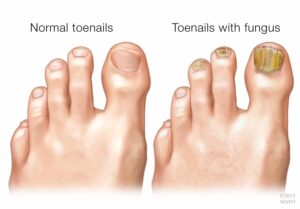We will discuss the best guide to softening fungal toenails. Softening toenails with fungus is an important part of grooming practices that you need to keep up with regularly. The origin of a fungal infection of the toenails varies. The condition is very contagious which can easily spread between people. Fungus commonly attaches to surfaces in public areas where people walk barefoot. Common surfaces may be public pools, locker rooms, beaches, and nail salons. After the fungus infects the nail bed, it can fall off onto surfaces that the toenail comes into contact with. The fungus can then survive on these surfaces, waiting for someone else to walk over them. This way fungus can find a new host. The fungal spores then attach to the nail and enter the nail bed. This causes an infection. Getting rid of a fungal infection once it has entered the nail bed is usually difficult. Fungus is a difficult organism to eliminate completely. The physical location of the infection under the nail bed only makes it more difficult.
Signs of nail fungus
Softening fungal toenails is only necessary when the nails have become disfigured in a way that affects their grooming. Typically, fungus doesn’t cause this and will actually only cause aesthetic damage. For example, the most common damage that toenail fungus causes is discoloration. Usually starting as a small dot or stripe on the nail. Discoloration of this sort won’t actually interfere with the regular use and maintenance of the nail. However, changes in the texture and composition of the nails are also very common. These changes can be more impactful for the maintenance of fungal toenails.
Debris buildup under the nail, cracking, brittleness, thickening, and hardening of the nail are very common compositional changes of the nails. These compositional changes are more likely to have functional issues. Nails that have become especially brittle or hard will be difficult to cut with nail clippers. The clippers often won’t go through the nail material because it has become too hard. Thickening because of toenail fungus can make the nails difficult to get inside of the blades of the nail clippers. For some people with especially thick nails, the distance between the two blades is simply not wide enough.

Reasons to soften fungal nails
Softening fungal nails can be very helpful to trim and groom. Grooming the nails regularly is important for many reasons, especially when they have a toenail fungus infection. Keeping the nails trimmed makes them appear to be clean. Keeping your nails at an average length will make the dirty look that toenail fungus caused less apparent. The alarming appearance that toenail fungus damage can cause will appear worse if the nails are also overgrown. Trimming your nails regularly will lessen the unclean look. It will also reduce the degree to which the fungus condition is noticeable to everyone. Trimming the nails is part of regular hygiene as well. And is important for everyone to do regardless if they have fungus or not. Ingrown toenails also are more common when nails are left overgrown. So trimming the nails regularly will protect you from that as well.
Ways to soften fungal nails at home
Softening fungal nails at home is very easily done without many additional materials required. Water and a basin to put it in are the only materials you need for this technique. Your nails should become softened by soaking in water. This, in turn, will make them easier to trim. Just fill the basin with enough warm water to cover your feet, and put your feet in it to soak! You can also add epsom salts if you would like, but this is optional. Let your feet soak in the basin of water for anywhere between 20 and 40 minutes. After this, you can remove your feet and see if nails have become easier to trim.

Other ways to soften toenails
Softening toenails with fungus at home won’t always be sufficient to groom nails at home. FIf the nail is too thickened from fungus to fit between the blades of the nail clippers at all, softening them won’t fix this. This should be done by a licensed podiatrist only (not at home), and is a process called debridement. This treatment will thin the nail down so that it is able to be trimmed and treated, and is usually done in conjunction with treatment for the fungus itself.
Finding ways to treat toenail fungus
Permanently softening fungal toenails can be done by treating the fungus itself. After eliminating the fungus from the nail bed, a new healthy nail should start to grow in behind the old damaged one. This nail should be clear, thin, and soft enough to cut. The best option for this treatment is the PinPointe laser, which typically requires only one treatment to eliminate the fungus from the nail bed. To find which of our 150 podiatry clinics is closest to you to get the PinPointe laser treatment, visit our page here.



